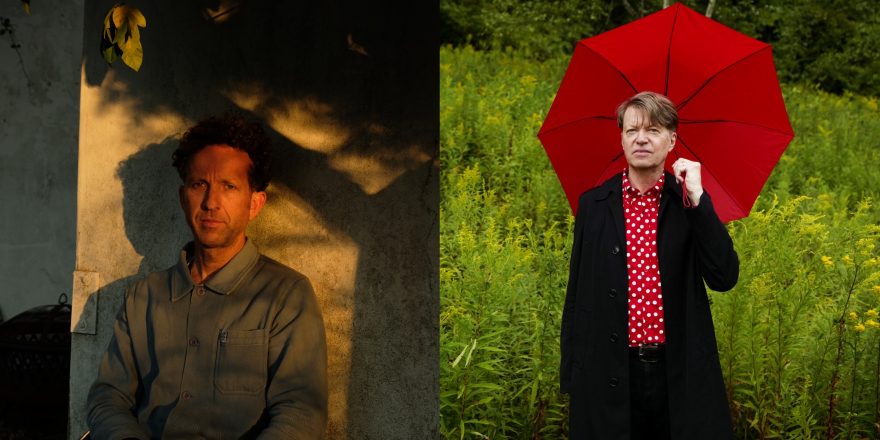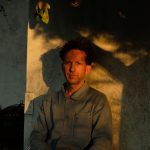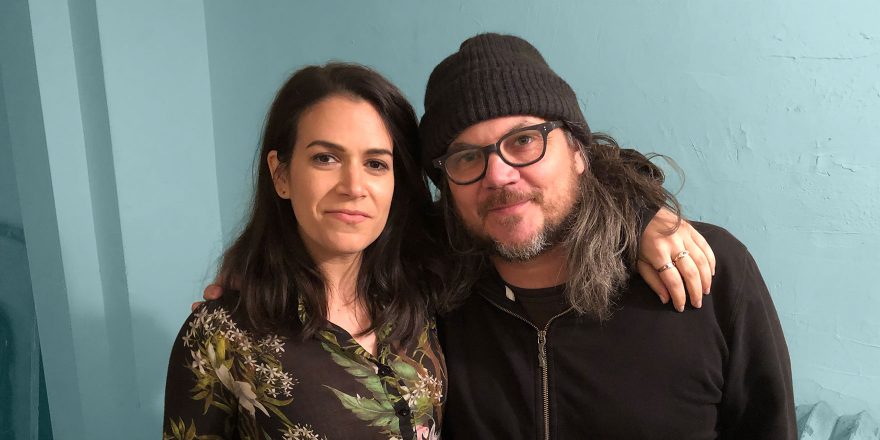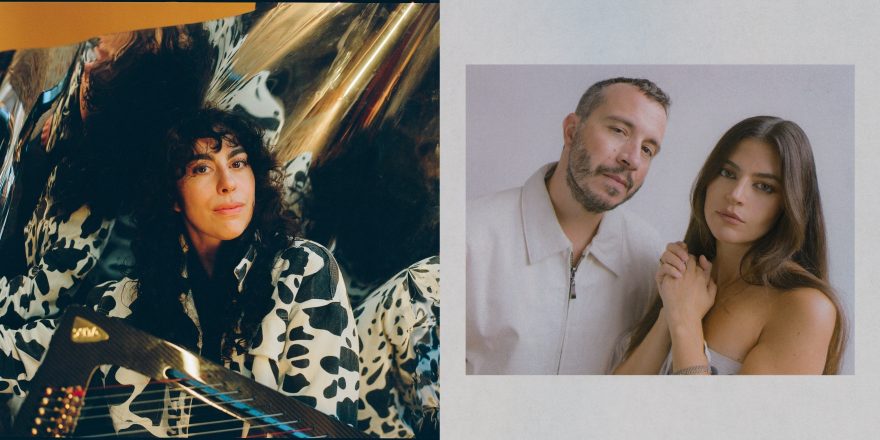Stephen Buono is a musician and producer, and the founder of Otherly Love Records; Nels Cline is a guitarist and composer, and the lead guitarist in Wilco. Otherly Love just put out the debut record from Stephen’s communal studio project Church Chords — featuring contributions from Nels, along with Jeff Parker, Kristin Slipp, Devon Hoff, and many more. Here, the two catch up about it, and about Nels’s early days in the LA jazz scene.
— Annie Fell, Editor-in-chief, Talkhouse Music
Stephen Buono: The other night, Bobby Bradford said he met you and Alex [Nels’s twin brother] when you were 15. Is that how you remember it?
Nels Cline: No. [Laughs.] Bobby doesn’t remember when he met me, but I was 18. I was a student at Occidental College and it came down to me, somehow, through my friend Lee Caplan, that John Carter and Bobby Bradford were looking for a guitar player. Or maybe just Bobby was. But I only knew of their music through Self-Determination Music and Flight for Four, and my first reaction was, Oh, no, that Ornette type stuff, I don’t know how to fit into that. But my philosophy professor at Occidental, William Neblett, let us use his living room one Sunday afternoon while he was away. Bobby started to write out — I don’t remember which song he was starting to write, but I must have had this look on my face because he looked at me and said, “Let me guess, you don’t read.”
Stephen: [Laughs.]
Nels: And I said, “Well, not very well.” And he said, “Well, just play what you’re feeling.” And at the end of playing he said, “You have a lot of facility. You ought to learn how to read music.” Which of course, I barely ever did. But he doesn’t remember this. I mentioned it to him a few years ago, and he didn’t have any recollection of it. But Alex and I and our friend Lee very often would go and hear John and Bobby play on Sunday afternoons at Rudolph’s Fine Arts Center.
Stephen: Where was that?
Nels: It was sort of Crenshaw area. Roberto [Miranda] or John Jr. would play bass, sometimes both of them. William Jeffrey on drums. Bobby also for a while, in Old Town Pasadena, had a storefront and he had Sunday jam sessions there. It was called the Little Big Horn. Just various people — Vinny [Golia] would play a little bit. James Newton showed up sometimes. I don’t know how long that lasted, maybe a year or two. And then and I ended up playing in Bobby’s Mo’tet many years later with Alex and Roberto and Vinny, sometimes with Chuck Manning instead of Vinny on saxophone.
Stephen: Were you living in Glendale at the time?
Nels: No, no. I lived on campus in the dorm. And then after that, I left Occidental to study music and I lived at home. I went to Santa Monica College and had my life changed by this excellent theory teacher named Rule Beasley, and I started to understand music finally. Because I was getting very poor instruction prior to that. I was just sort of starting to learn music in high school, but I didn’t think I’d ever get it ‘til I had Rule Beasley. I started over with theory and took his Commercial Harmony and Arranging class, and his 20th Century Orchestration class, and Baroque Harmony first. Then I moved in to my friend Alan Eder’s house in Santa Monica when his roommate left, and lived there for about 20 years.
Stephen: Oh, wow. With the Mo’tet, when did that start? What years was that happening?
Nils: I don’t know. He did it for a really long time. It kind of went on and off. Because prior to that, it was always Bobby and John playing together — it was the New York Jazz Quartet, which sort of became more known as John Carter and Bobby Bradford Quartet. The New York Jazz Quartet had Bruz Freeman on drums — I’m trying to remember the bass players. But by the time they were playing together in different iterations, it was usually with Roberto Miranda on bass and William Jeffrey pretty much always on drums. How that ended up morphing into the Mo’tet with Alex and me, I don’t really remember. I don’t think I was at the ground floor of that. I think they were playing for a while before Bobby decided he wanted me to join in.
I’d been playing with Bobby and John in Charlie Haden’s Liberation Music Orchestra, West Coast. I guess Charlie started it around 1984, and it went for three years, maybe, before he turned that into a student ensemble at Cal Arts where he was teaching part time. That’s when we all stopped doing it. But Bobby quit before any of that happened. Bobby didn’t really dig how it was going down.
Stephen: Were you doing The Ballad of the Fallen material or what?
Nels: The first two albums, yeah. Mostly Ballad of the Fallen, and sometimes we’d do “Song for Ché.”
Stephen: And you were doing mostly nylon.
Nels: All nylon.
Stephen: I love that music.
Nels: Yeah. It’s heavy. I can’t believe I got to play that music. It was literally like a dream come true. It was very difficult — I was very nervous. I was the youngest guy, the only non-union guy working in the record store, at Rhino Records at the time. I even did a window display for Ballad of the Fallen — it was a pretty cool display, I have to say. But yeah, it was fun. It was hard. I was nervous, but Charlie was really nice.
Stephen: And the music was poignant because of what was happening in Central America and Ronald Reagan at that time.
Nels: Definitely. I felt very strongly about the political implications of the music, and I know that it was extremely important to Charlie. In deference to Bobby Bradford, he’s rather conservative politically, and he didn’t dig Charlie’s whole left wing, rabble-rousing thing too much. But I think more so just the way [Charlie] would run the band kind of irritated Bobby, because it was so bizarre the way he would do it. The first rehearsal we had, he played us the record — it was on a boombox, and I think people were all kind of looking at each other like, Huh? And I was just completely freaking out, because I couldn’t believe I was even there.
Stephen: In the West Coast version of the Liberation Music Orchestra, who else was in that?
Nels: Well, let’s see. I mean, there’s some people I don’t remember, but Ernie Watts and Marty Krystall were the saxophone players. Milcho Leviev on piano. William Jeffrey on drums. Originally, there was a tuba player named Tom Heasley, and he got fired, and Erik Messerschmidt played tuba. Oscar Brashear played trumpet. Bobby Cornett initially, and then after he left, Charlie got Stacy Rowles in there, which I think was a brilliant move. She and I ended up playing together.
Stephen: Did she play trumpet?
Nels: She played trumpet and flugelhorn, yeah. She passed away many years ago, unfortunately. Oh, dear. Anyway, loved Stacy so much, and she’s so overlooked at this point. She was always underrated in my opinion. But she was such an eloquent player. I’m blanking on the French horn player’s name — he was a session guy, he was very good. And who am I forgetting? John Carter!
Stephen: So would you and Alex work with John?
Nels: I never worked with John other than the Liberation Music Orchestra. Alex and John had a thing — they would get together afternoons after John had finished teaching, in what had been my room behind my parents’ house where Alex’s drums were set up. They would just go at it, just completely free duo. It was really incredible, really intense. Alex did some gigs with John at the Century City Playhouse, the concert series that our friend Lee Caplan started in the ‘70s, which hosted not just local people — like me and Alex and Vinny, and Jeff Gauthier, Eric Von Essen, Mike Steffens, Kurt McGettrick — but also ultimately Wadada Leo Smith and Julius Hemphill and Oliver Lake and Art Ensemble of Chicago and Sonny Simmons, Eugene Chadbourne, and John Zorn Duo. You know, a lot of adventurous music.
Stephen: So was Bobby Bradford kind of your entry into playing that kind of music, with veterans of it? He told me how he met Lester Young when he was super young… Was that the first time you crossed paths with living legends, or people that would become legends?
Nels: Meeting Bobby when I was at Occidental was pretty early on, so yeah, he was the first guy that I can recall. Not much later, we met Vinny Golia, and Vinny became someone who was very frequently at my parents’ house many days a week, eating dinner with us after we all jammed out in the back room. So Vinny became sort of incalculably important. Alex started playing with Julius Hemphill, and by this time we had also jammed with Oliver Lake when he was in town. This would probably be around ‘77 or so. But Alex went out with Julius on tour, played with him at the Playhouse, played with him up in Berkeley, played with him in Philadelphia, recorded with him in New York City, and then went on tour with him in Europe for a few weeks. So things were starting to get pretty interesting as far as what Alex was doing, and that sort of trickled down to me periodically.
My interest was much more in the area of more conventional harmonic material, and I found playing Vinny’s music, for example, to be very challenging because of the lack of specific harmonic information. I was listening to people like Ralph Towner, John Abercrombie, Bill Connors, John McLaughlin. And then very significant to me at the time was Michael Gregory Jackson, what he was doing with Oliver Lake’s music. I felt that he had discovered somehow, or had created, a really good language for the guitar in what you might call a free jazz with composition kind of setting. Those records were so fantastic.
Stephen: Was it his usage of the volume pedal? Someone — who’s maybe a contemporary of yours — told me that was the first time he heard a volume pedal used in that fashion, and how he thought it sounded like a French horn the first time he heard it.
Nels: Oh, interesting. Well, maybe. I was very much on the volume pedal at that time. I picked up the volume pedal because of Robert Fripp and Steve Howe, basically. Then what John Abercrombie was doing with it — and he didn’t stick with it all that long — that became very informative. But it was really what Michael was doing, just in terms of the lines that he would play and the sound that he would use, which was kind of rock-ish but not a rock sound. He would play acoustic guitar and sing sometimes, in Oliver and Michael Gregory’s duo, and he was, like, angelic. It was almost like folk music. It’s on that first record — there’s a solo piece on Clarity, his first record, that’s recorded at the Century City Playhouse during a duo gig he did with Oliver there. It’s beautiful.
Stephen: But Oliver never lived [in LA], right?
Nels: No, no. Caplan would just somehow get in touch with these people and convince them, if they were playing on the West Coast, to come to Los Angeles. Prior to that, people would skip Los Angeles. They felt they had nowhere to play, no audience. And some people really refused to play Los Angeles ultimately, like Cecil Taylor and John Zorn. Because Los Angeles was bad. [Laughs.]
Stephen: So do you think those shows were kind of the beginning of people making a stop in Los Angeles.
Nels: Oh, definitely. It was done in concert with Rhino Records, which sort of underwrote some of the expenses. Which were very few, actually. This guy Ivan Spiegel ran the Century City Playhouse — which was a tiny theater, a little black box. I don’t think it could have held more than 50 people. The concerts were, as I recall, always on Sunday evenings. I would work the door; I would take people’s money and give them some kind of little fake ticket or something. It was really cool. It definitely changed things, as far as I can see, and brought a lot of other people from the community to the Playhouse to hear the music. When I had a concert series later at the Alligator Lounge, I think it was one of the only other example of a successful concert series, in terms of bringing people from all over the Los Angeles area, or even the Southern California area.
Stephen: How soon after did you start your series?
Nels: Way later. I started my series in the mid-‘90s.
Stephen: Oh, OK.
Nels: My first trio, the Nels Cline Trio, opened for Brand X at the Alligator Lounge, and one of the two owners — this guy named Milt Wilson — really liked what I was doing and asked if I’d want to play there more often. I said yeah. You know, I could drive, like, three minutes from where I lived in Santa Monica to this place, which was convenient. It was really small, and it was it had been a jazz restaurant called the Loa, run by these Hawaiians, so it was kind of funky. What ended up happening with Milt was: he ended up with colon cancer and he was hospitalized and almost died. When he came out of the hospital, he asked me to come to the club and meet him. He had a partner, whose name I don’t remember, but he seemed to be more interested in classic cars than in music — they were total dudes, these guys, but older. Their big night was Sunday night Cajun dancing. But anyway, he asked me to meet him, and he said that — in what I imagined to be a kind of near death experience, weird revelation — I needed to do a concert series there on Monday nights with what he called my “group of new bohemians.” So I said, “Yeah, I’ll do it.”
That went for about four years, until the Alligator Lounge closed for health code violations, and the discovery that almost all the permits were out of date. By then there were different owners; Milt had died, and the other guy sold it to a couple that owned the Palomino out in North Hollywood. We soldiered on and it did pretty well, the first couple of years especially. My trio anchored it, except when I was on tour — I was with Mike Watt, and later with the Geraldine Fibbers, and then again with Mike Watt. It all crashed and burned in 1998, when they got closed down.
Stephen: So during that time, like you are now, you were playing in all these different musical communities.
Nels: Yeah, yeah. It’s kind of amazing when I think about how many things in the ‘80s I was doing all at once. Not making any money doing it, certainly. But besides playing sporadically with the Liberation Music Orchestra, I had Quartet Music with Jeff Gauthier, Eric Von Essen, and Alex. We started in 1980, I think, and went for 11 years. That was an outgrowth of my duo with Eric Von Essen that started in the late ‘70s. Then I was in a band for eight years called BLOC, a sort of funky rock band with Steuart Liebig and Nick Kirgo. Great guitar player Camille Henry sang, and Chris Mancinelli on drums. We played just in Los Angeles, but we would rehearse a lot. I was playing with Vinny sometimes and doing this and that. Starting with Bobby was the ‘90s, maybe early aughts — that was way later. But I was constantly doing stuff, and then working full time in a record store.
Stephen: I’m not really sure what we should do in terms of talking about our working together…
Nels: Well, I could say this: You and I met pretty randomly. It’s been a few years now, more than I probably am aware of, and it was music that brought us together. After many hangs and concerts — in Philadelphia and Chicago and Los Angeles and New York — you started a record label, which would be probably the most quixotic thing to do at this point in time in the United States. My hat’s off to you. I see your endeavor as being sort of a curated world, wherein everything is flowing through your aesthetic sense and your most cherished collaborators. Aesthetically, it reminds me a little bit — if I may generalize — of the the sort of Bill Laswell improv-but-not-improv bands, like Praxis. That whole universe. It’s kind of free, it has a lot of individuals involved, but it’s curated, it’s controlled by you, the artistic director. You have an idea and you follow through with it, and that’s what the Church Chords record, I think, says loud and clear. It’s a really excellent execution of this idea of taking raw material and forming it into… maybe song-like structures, but certainly heavy grooves. It’s something that you can just put on and let go. It has its surprises, but it is something that you can fit into your lifestyle, if you’re into that vibe. Does that make sense?
Stephen: Yeah, definitely. The other music I’ve done in the past is more rock sounding, and I wanted to do something that was a little less harsh. Just something you could listen to in any context… Well, cool, man. Thanks for doing this.
Nels: You got it. Much love. Talk to you every 10 minutes.
Stephen: [Laughs.]
(Photo Credit: left, Matthew Gribben)







